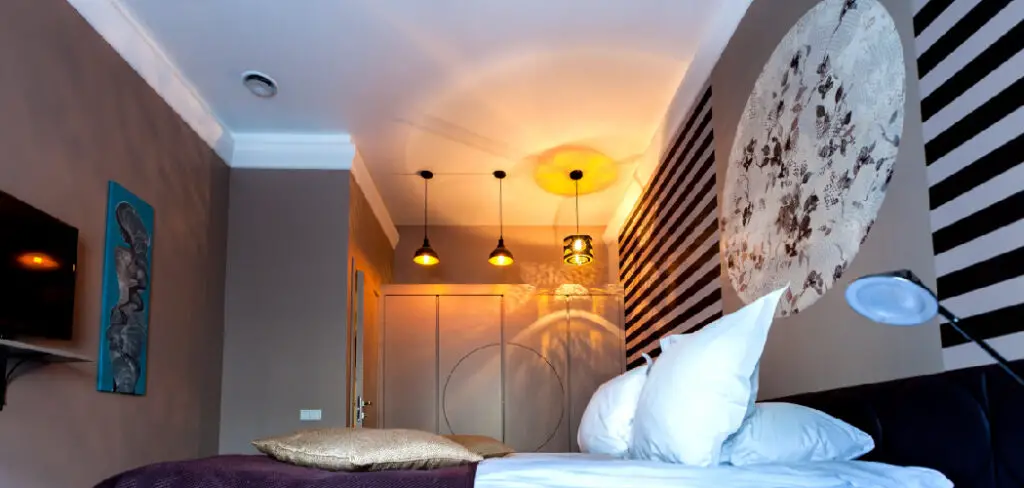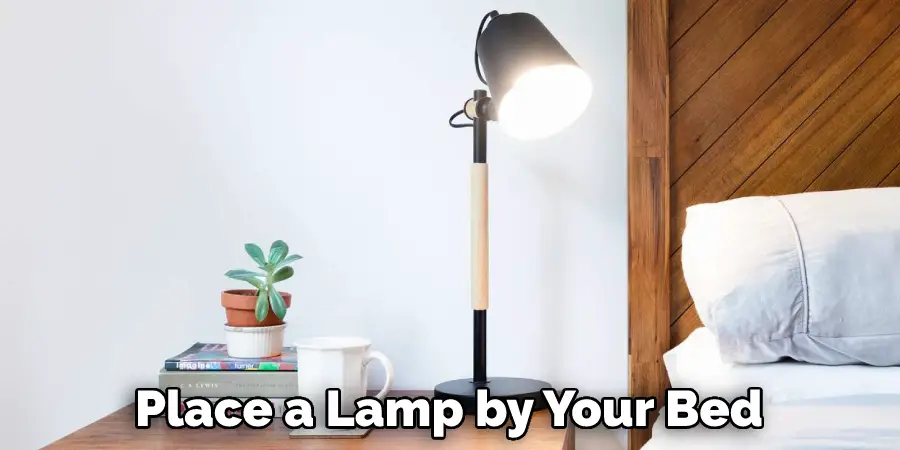It is often best to light a bedroom without overhead lighting for several reasons. Firstly, overhead lights can be very bright and cast harsh shadows, making it difficult to relax in a bedroom. Additionally, bedrooms that are illuminated only with natural light during the day tend to have a more balanced atmosphere, as artificial lighting, such as ceiling lights, can cause glare and reduce visibility. Finally, overhead lighting can create an overly bright atmosphere in a bedroom, making it difficult to sleep or relax.

One of the primary advantages of lighting a bedroom without overhead lighting is that it allows for more flexibility and creativity in the design. Without an overhead lighting fixture, you can incorporate different types of lamps into your décors, such as table lamps, floor lamps, wall sconces, or even chandeliers. This will allow you to customize the lighting in your bedroom to create the ambiance you desire. In this blog article, you can find step-by-step instructions on how to light a bedroom without overhead lighting.
Step-by-step Instructions for How to Light a Bedroom Without Overhead Lighting
Step 1: Inspect the Room
Before adding lighting, look at the room and identify any obstacles that could affect your lighting plan. Take note of furniture placement, window size and shape, wall colors, the height of the ceiling, and existing power outlets.
Step 2: Consider Task Lighting
Task lighting is a must when there is no overhead light in a bedroom. Consider adding additional lamps to areas where you need more light for reading, working, or crafting. Make sure that any windows in the room are uncovered and that blinds, shades, or curtains are pulled back as far as possible to allow natural light into the room.
Step 3: Add Accent Lighting
Wall sconces, floor lamps, and table lamps can all be used to create a cozy atmosphere in the bedroom, even without overhead lighting. When selecting these types of lights, look for ones that complement the decor of your room. Adding mirrors to walls will help maximize natural light and reflect artificial light. Mirrors can also help make a small room look larger, making it appear brighter and more spacious.

Step 4: Get Creative with Lighting Fixtures
For those who want to add extra style to the bedroom, consider installing unique lighting fixtures such as chandeliers, pendant lamps, or string lights. If there is no overhead lighting in the bedroom, you can use wall washers to bathing the ceiling in light. Wall washers are a great way to help create an ambient atmosphere in the room without installing overhead lighting.
Step 5: Use Color-changing Lights
Adding color-changing lights to the bedroom can help create a warm and inviting atmosphere. These lights are available in many different styles, from recessed lighting to string lights, so you can find one that fits your existing decor. If you don’t want to use too much energy to light the bedroom, consider adding motion sensor lights. These lights will turn on when they sense movement in the room and then turn off again when no one is present.
Step 6: Don’t Forget the Dimmer Switch
Dimmer switches are a great way to control the intensity of the lighting in a bedroom. Dimmer switches allow you to adjust the brightness of any light source, making it easier to create just the right mood for any occasion.
Following these steps will help you create a beautiful and well-lit bedroom without installing overhead lighting. With some creativity and the right lighting fixtures, you can create a cozy and inviting atmosphere in the bedroom, no matter what type of lighting you have.
Safety Tips for How to Light a Bedroom Without Overhead Lighting
- Use energy-efficient lighting such as LED, CFL, and Halogen bulbs to avoid wasting electricity.
- Place lamps away from the bed or any items that may be flammable to avoid fire hazards.
- Keep an eye on extension cords, power strips, and plug adapters, so they are not overloaded with too many devices.
- Use the correct wattage bulbs when replacing them in lamps and overhead lighting fixtures.
- Install dimmers to create different levels of light in the bedroom.
- Place small lamps around the bed for more ambient light that can be adjusted to the optimal comfort level.
- Choose floor, wall, and table lamps that complement the style of the bedroom.
- Avoid using fluorescent lights in the bedroom, as they can cause eye strain and headaches.

Following these safety tips will help ensure you have a safe and comfortable experience lighting your bedroom without overhead lighting. With the right setup, you can create an inviting atmosphere that is perfect for restful nights and productive days.
What Type of Lighting Fixtures Should You Use to Avoid Overhead Lighting?
When it comes to creating a cozy and inviting atmosphere in your bedroom without the use of overhead lighting, you have several options. The key is choosing lighting fixtures that provide indirect illumination while still providing enough light to move around safely.
Table lamps are an excellent choice as they provide ambient light while also adding a decorative touch. Floor lamps are a good option, too, as they can be positioned in various spots to adjust the lighting to your preference. Wall sconces also provide indirect illumination and look great in any room, especially when placed beside a bed or reading chair. If you’re looking for something more unique, consider hanging pendant lights from the ceiling to create a warm, ambient light and add some character to your bedroom.
Consider using table lamps on each side of the bed or floor lamps near a reading chair for task lighting. If you have a dresser in the bedroom, put a lamp there as well for additional illumination when getting ready in the morning. You can also use track lighting on the walls to provide directional light that can be adjusted up or down.
How Much Light Should You Use to Avoid Straining Your Eyes When You’re in Bed Trying to Read or Watch Tv?
The best way to light a bedroom without overhead lighting is to use task-specific lamps. This means using smaller, more focused pieces of lighting placed near the area where you need it most. For example, if you’re trying to read in bed, then place a lamp by your bed or desk chair so that it illuminates the page without straining your eyes. Alternatively, if you’re watching television in bed, a lamp behind the TV can help light up the room without creating too much glare or making it difficult to see.

The key is to use enough lighting so that you don’t strain your eyes but not too much that it becomes uncomfortable or overwhelming. You also want to ensure that most of the light is focused on where you need it rather than flooding the entire room with unnecessary light. This will help to create a comfortable atmosphere in your bedroom, allowing you to relax and enjoy your time while in there.
What Safety Considerations Should You Keep in Mind When Using Lighting Fixtures Other Than Overhead Lighting?
When opting to use lighting fixtures other than overhead lighting, it is important to keep safety in mind. Make sure that any lamps you choose are securely installed and are out of reach of pets, children, and other potential hazards. Be mindful of each lamp’s wattage, and don’t overload a circuit by plugging too many lamps in at once. Use a surge protector to protect your electronics and lighting fixtures from power surges if possible.
Additionally, it is important to ensure that cords are not frayed or damaged and that the connections between lamps and outlets are secure. Finally, avoid mounting anything above the bed, as it may put you at risk of an electric shock if it falls. By considering these safety considerations, you can easily light your bedroom without overhead lighting and ensure that everyone in the space is safe.
Conclusion
One of the major disadvantages of lighting a bedroom without overhead lighting is that it can create an unbalanced look in the room. Without overhead lighting, shadows and darker corners can be created in areas without enough natural light or other fixtures to provide adequate illumination. Using multiple types of light sources will allow you to evenly distribute the light throughout the bedroom, creating a more comfortable atmosphere.

In conclusion, lighting a bedroom without overhead lighting is absolutely possible! By deciding on the type of atmosphere you want and considering the natural light, wall sconces, lamps, floor lamps, and recessed lights can be used to create a warm and inviting space. With these tips in mind and some creativity, you can craft a beautiful and unique look for your bedroom. I hope reading this post has helped you learn how to light a bedroom without overhead lighting. Make sure the safety precautions are carried out in the order listed.

